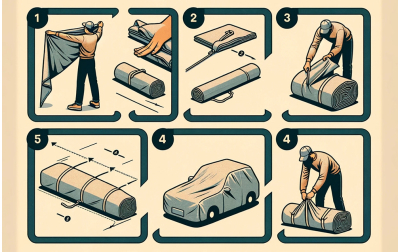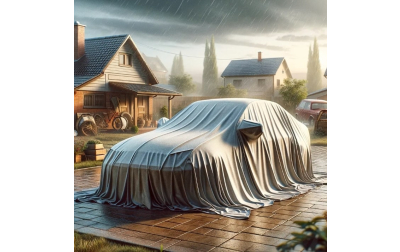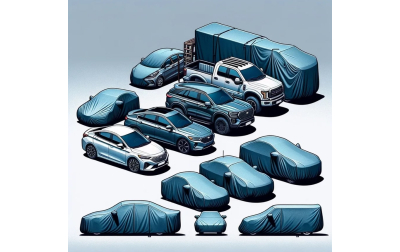
Storing Your Car In Winter
Introduction
As winter approaches, it's important to protect your car from the harsh elements to maintain its value and ensure it’s ready to drive when spring arrives. This guide will cover everything you need to know about storing your car during the winter months. In this blog, we’ll talk about:
- Why Winter Storage is Important
- Steps to Properly Store Your Car in Winter
- Using a Car Cover in Winter Without a Garage
- Winter Car Storage Tips for Spring
- FAQ: Storing Your Car in Winter
By following these steps, you'll keep your vehicle safe and in top condition, whether you're storing it indoors or outdoors without a garage.
Why is Winter Storage Important?
The cold winter months can take a toll on your vehicle. Low temperatures, ice, snow, and salt used on roads can cause corrosion, damage your car’s exterior, and affect its performance. Even if you're not driving the car during winter, improper storage can lead to long-term issues such as dead batteries, flat tires, and rust. Proper winter storage helps you avoid these problems, preserving the car's condition and value.
Steps to Properly Store Your Car in Winter
1. Clean the Car Inside and Out
Before storing your car, thoroughly wash and wax the exterior. Dirt, grime, and salt can cause rust and paint damage if left on the vehicle for an extended period. Pay extra attention to the undercarriage, as this area is especially prone to corrosion.
2. Change the Oil and Other Fluids
Oil can break down and become contaminated over time, so it's a good idea to change the oil before storage. Also, top off other important fluids like coolant, brake fluid, and windshield washer fluid. This will help prevent freezing and keep your car ready for action once winter is over.
3. Fill the Gas Tank
A full gas tank helps prevent moisture from building up inside, which could lead to rust and damage to the fuel system. Adding a fuel stabilizer is also highly recommended.
4. Inflate the Tires
Cold temperatures can cause tires to lose pressure. Ensure your tires are properly inflated before storage. If your car will be stationary for a long time, consider using tire jacks or blocks to relieve pressure and avoid flat spots.
5. Protect the Battery
Disconnecting the battery or using a battery maintainer can prevent the battery from draining over the winter months. If you’re storing the car in a location with extreme cold, it might be best to remove the battery and store it in a warmer, dry place.
6. Use a Car Cover
If you’re storing your vehicle indoors, a high-quality winter car cover will protect it from dust and minor dings. For outdoor storage, a weatherproof car cover is essential to guard against snow, ice, and moisture.
7. Seal Off Entry Points
To keep pests from nesting in your car, seal off any potential entry points such as the exhaust pipe or air intakes. You can use steel wool or other deterrents. Additionally, placing mothballs or cedar chips around the car can help deter rodents.
8. Lubricate Hinges and Moving Parts
Spray hinges, door locks, and any other moving parts with a lubricant like WD-40 to prevent them from freezing or becoming difficult to operate after being unused for a while.
9. Ventilation and Climate Control
Consider using a dehumidifier or moisture absorber in the garage to keep humidity levels in check. Excessive moisture can lead to rust, mold, and other damage.
10. Check Insurance and Registration
Ensure your car’s insurance and registration are up to date even if it won’t be driven during the winter. Look for storage-specific policies or discounts to save on coverage.
Using a Car Cover in Winter Without a Garage
If you don’t have a garage, a car cover can still protect your vehicle. Follow these tips for proper outdoor storage:
1. Choose a Weatherproof Car Cover
Use a heavy-duty, weatherproof car cover that repels water, ice, and snow while allowing moisture to escape to avoid rust or mildew buildup.
2. Ensure a Snug Fit
The car cover should fit snugly to prevent wind from lifting or moving it, which can scratch the paint.
3. Check the Car Regularly
Periodically inspect under the cover to remove moisture or snow buildup and check for pests or debris.
4. Use a Protective Layer
In areas with harsh winters, consider placing a soft layer under the cover to add extra protection for your car's paint.
5. Monitor Ground Conditions
Parking on gravel or pavement is ideal to avoid moisture rising from the ground. If necessary, place a plastic sheet under the car.
Winter Car Storage Tips for Spring
Once winter is over, reconnect the battery, check tire pressure, and inspect for any signs of damage before driving. A short test drive will help ensure all systems are functioning properly.
FAQ: Storing Your Car in Winter
1. Should I store my car with the windows open or closed?
It’s best to keep the windows slightly cracked to allow airflow and prevent moisture buildup inside the vehicle.
2. Can I store my car outside during winter?
Yes, but outdoor storage requires a high-quality, weatherproof car cover. It's also important to check the car periodically for any signs of damage or wear due to the elements.
3. What is the best temperature to store a car in winter?
Ideally, you should store your car in a location that remains above freezing. A climate-controlled garage is the best option, but if that’s not possible, try to minimize exposure to extreme cold.
4. How often should I start my car while it's in storage?
Starting your car every few weeks can help keep the engine and battery in good shape. However, if possible, take the car for a short drive to allow all the fluids to circulate properly.
5. What is a fuel stabilizer, and do I need it?
A fuel stabilizer prevents the gas in your tank from breaking down over time. It’s essential for long-term storage, as degraded fuel can cause engine issues.
6. Should I disconnect my car battery during winter storage?
Yes, disconnecting the battery will prevent it from draining. Alternatively, you can use a battery maintainer to keep it charged.
7. Do I need to change the oil before storing my car?
Yes, changing the oil is recommended, as old oil can contain contaminants that may cause damage during storage.
8. How do I prevent rodents from damaging my car?
Seal any entry points, use deterrents like mothballs, and check the car regularly for signs of pests.
9. Can I cover my car with a tarp instead of a car cover?
A tarp is not recommended as it can trap moisture and scratch the paint. Invest in a proper car cover that is breathable and tailored for car storage.
10. How should I prepare my tires for winter storage?
Ensure the tires are properly inflated and consider using tire jacks or blocks to prevent flat spots. If that’s not possible, try to move the car slightly every few weeks to shift the tire's position.
















